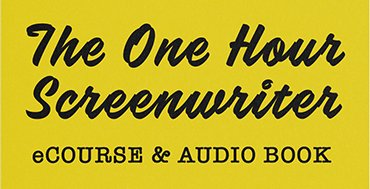#WritingAdviceWednesday – Writing Exercises: Talk To Me
Writing Advice Wednesday
Welcome back to Writing Exercises! Hope you enjoyed the last few weeks of Halloween fun and Community-themed content, but now it’s back to the writing gym!
As well as a relevant video essay I’ve found, I’m giving you writing exercises to use if you’re keen to either explore and experiment or need some motivations to start a new script or novel.
It’s exercises like this that form part of my One Hour Screenwriter course, which will help you write an entire feature film script in 22 weeks. You can purchase it at the shop here. You can also read testimonies here that show my methods have worked for a variety of writers.
This week, you’ll be writing about talking:
Create Distinctive Speech Patterns
Each of your characters should have a distinctive way of speaking. A reader should be able to tell who is talking by the dialogue alone, without necessarily looking at the character’s name. Check out Talk Like a Gangster on Types Tuesday.
Use the following exercise to practice creating a distinctive “voice” for each of your characters.
First, find a physical practice subject. Cut out a series of comic strips (all featuring the same characters) from your local newspaper, buy a comic book, or find a series of comics on the web. Use comic strip characters you don’t know well but which interest you visually.
Block out or white out the dialogue in the individual speech bubbles. Photocopy the story panels with the now blank bubbles.
Look at the visual element of the comic, without the words. Note the style and tone of the drawings. Re-imagine the characters and story. Make it your own.
Fill in the blank speech bubbles with your own imaginary dialogue. Find a different rhythm and sentence construction for each character. Make your characters’ speech patterns reflect how they look visually.
Is one character’s speech more verbose and flowery than another? Is another character crisper and minimal in the way he or she speaks? Does one character joke in order to make a point? Does another preach and scold? Does another always try to impress?
Experiment with different speaking styles. Be consistent in creating each individual character’s way of communicating. Make each character’s speech pattern reflect that specific person.
Can you make the visual images work with the dialogue? Can you use the visuals as an interesting counterpoint or contrast to what is being said?
What happens when characters have a serious discussion in a silly setting? What happens if they have a silly argument in a serious setting? How can you reveal character by small discussions or ridiculous disputes that reflect much deeper underlying concerns?
For example, create an argument about taking out the kitchen trash. Make the deeper underlying concern about a larger issue in the relationship or a more fundamental personal dissatisfaction between the two.
Now how can you apply these principles to the characters in your screenplay? How can you make each of your characters’ speech patterns more distinctive?
How do their speech patterns reflect their individual personalities? How does it match or is it at odds with their physical appearance?
How can you use setting or location to underscore, be a counterpoint or comment on the discussion?
How can your characters reveal themselves by the mundane or foolish things they argue about? How does the argument reflect larger disagreements?
Video Essay of the Week
How Characters communicate tells us everything about them, from how to talk to others and also how they express themselves (or avoid exposing themselves.
We communicate with family members in a different way to friends than with enemies, for example. This excellent video essay talks us through the different ways three brothers communicate on the road-trip of a lifetime in Wes Anderson’s The Darjeeling Limited:
Let me know what you think of this week’s writing exercise by emailing me at [email protected]. I’d love to hear from you as we go forward with more of these writing exercises. Next week, we’ll be writing about… nothing…
Until then, remember- all you need to do is Get Started and Keep Going!
– Laurie



Create a visual map for a character’s emotional journey. Pull stories from character rather from rote story structure beats. Some of the largest international media companies, use this in story and character development.


A clear concise guide for writers and producers to have by their side as they embark on a project. It gives a really vital reminder of what is key for story success.

No comment yet, add your voice below!